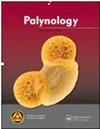标题伊朗芸苔科Matthiola及其相关属Dvorakia的花粉形态
IF 1.3
4区 地球科学
Q3 PALEONTOLOGY
引用次数: 0
摘要
摘要本研究对13种Matthiola属及其近缘属Dvorakia的花粉形态进行了研究。利用光镜和扫描电镜研究了花粉特征对这些属的分类的重要性。对花粉粒进行乙酰化、测量、拍照,并根据定性和定量特征进行描述。在这里,我们对定量数据进行统计分析和多元统计。两属的花粉均为三柄,形状从近长形到长形不等。我们根据管腔宽度来区分两种花粉类型。黄松花粉既有网状纹饰,也有大网状纹饰;黄松花粉为网状纹饰。外壁的厚度和中果皮的宽度是除外壁纹饰外的重要特征。伊朗Dvorakia和Matthiola的花粉大小可分为四种类型,其中一种为I型(Dvorakia alyssifolia-type)。在所调查的物种中,毛毛蓟的花粉粒最小,而白花蓟的花粉粒最大。花粉形态证实了D. alyssifolia从Matthiola转移到Dvorakia。此外,我们提出了一个属的种键。关键词:孢粉;扫描电镜研究;分类;免责声明作为对作者和研究人员的服务,我们提供此版本的已接受稿件(AM)。在最终出版版本记录(VoR)之前,将对该手稿进行编辑、排版和审查。在制作和印前,可能会发现可能影响内容的错误,所有适用于期刊的法律免责声明也与这些版本有关。本文章由计算机程序翻译,如有差异,请以英文原文为准。
Pollen morphology of Matthiola and the related genus Dvorakia (Brassicaceae) in Iran
ABSTRACTOur study focused on the pollen morphology of 13 Matthiola species and the closely related genus Dvorakia. We used light and scanning electron microscopes to examine the importance of pollen characteristics in classifying these genera. Pollen grains were acetolysed, measured, photographed, and described based on qualitative and quantitative characteristics. Here, we present statistical analyses and multivariate statistics for quantitative data. Pollen in both genera is tricolpate and varies in shape from subprolate to prolate. We distinguish two pollen types based on lumen width. Matthiola pollen has both reticulate and macroreticulate ornamentation, while Dvorakia alyssifolia pollen is reticulate. The thickness of the exine and the width of the mesocolpium are important traits in addition to exine ornamentation. Iranian Dvorakia and Matthiola species' pollen size can be divided into four types, one of which is Type I (Dvorakia alyssifolia-type). Among the examined species, M. tomentosa has the smallest pollen grains, while D. alyssifolia has the biggest grains. Pollen morphology confirms the transfer of D. alyssifolia from Matthiola to Dvorakia. Additionally, we propose a species key for the genera.KEYWORDS: palynologyscanning electron microscopic studytaxonomytricolpateDisclaimerAs a service to authors and researchers we are providing this version of an accepted manuscript (AM). Copyediting, typesetting, and review of the resulting proofs will be undertaken on this manuscript before final publication of the Version of Record (VoR). During production and pre-press, errors may be discovered which could affect the content, and all legal disclaimers that apply to the journal relate to these versions also.
求助全文
通过发布文献求助,成功后即可免费获取论文全文。
去求助
来源期刊

Palynology
地学-古生物学
CiteScore
3.40
自引率
26.70%
发文量
48
审稿时长
>12 weeks
期刊介绍:
Palynology is an international journal, and covers all aspects of the science. We accept papers on both pre-Quaternary and Quaternary palynology and palaeobotany. Contributions on novel uses of palynology, review articles, book reviews, taxonomic studies and papers on methodology are all actively encouraged.
 求助内容:
求助内容: 应助结果提醒方式:
应助结果提醒方式:


